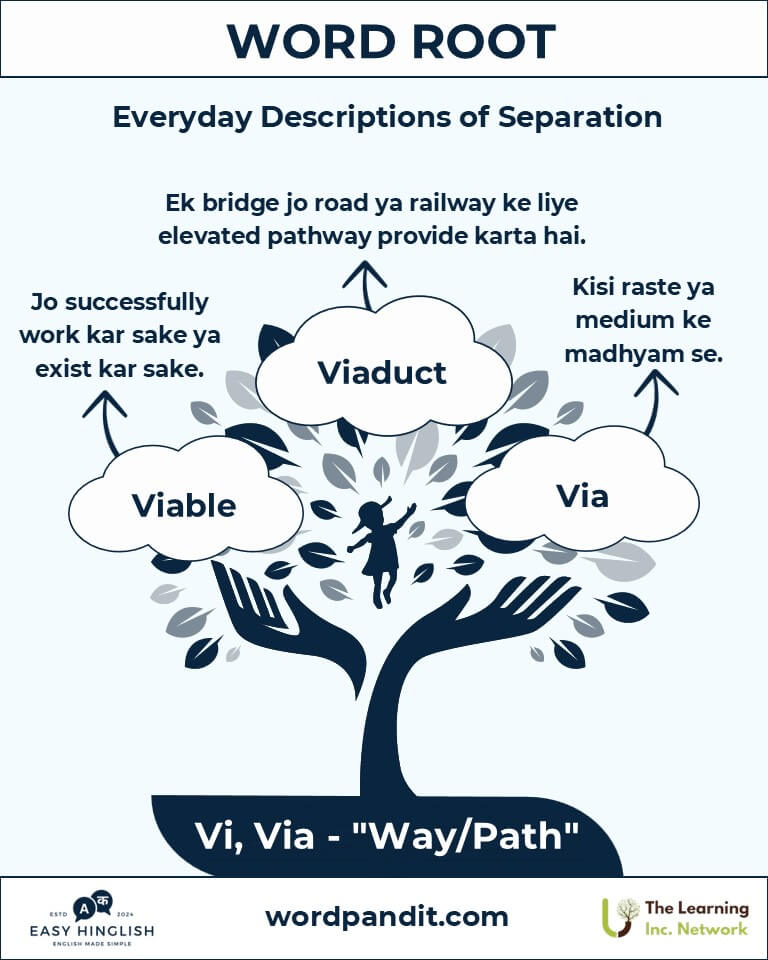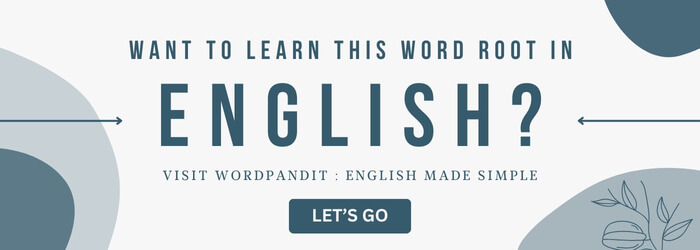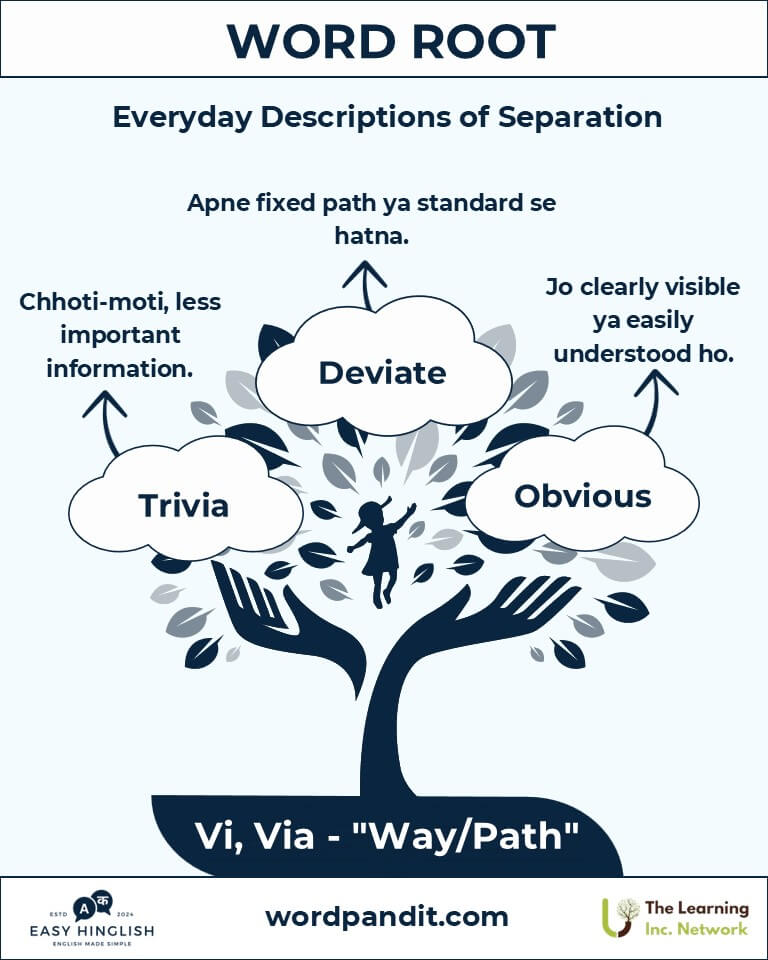Vi/Via: The Pathway to Progress in Language and Meaning
(Vi/Via: Bhasha aur Arth mein Pragati ka Rasta - भाषा और अर्थ में प्रगति का रास्ता)
Explore the versatile Latin root "vi/via," meaning "way" or "path" (रास्ता), and its profound impact on language. Words like "viable" (व्यावहारिक) and "deviate" (विचलित होना) highlight how this root helps us navigate life's decisions.

Table of Contents
- Introduction: The Essence of Vi/Via
- Etymology and Historical Journey
- Mnemonic: Unlocking the Power of Vi/Via
- Common Vi/Via-Related Terms
- Vi/Via Through Time
- Vi/Via in Specialized Fields
- Illustrative Story: Vi/Via in Action
- Cultural Significance of Vi/Via
- The Vi/Via Family Tree
- FAQs About the Vi/Via Word Root
- Test Your Knowledge: Vi/Via Mastery Quiz
- Conclusion: The Living Legacy of Vi/Via
Introduction: The Essence of Vi/Via
When we talk about "viable solutions"(व्यावहारिक समाधान or someone choosing to "deviate"मार्ग से हट जाना from a path, we are using the root "vi/via." This Latin root means "way," "path," or "road." It is used not only for physical pathways but also for metaphorical journeys and decisions.

Etymology and Historical Journey
The root "Vi/Via" comes from the Latin word via, meaning "way" or "road." The "viae" (roads) of Ancient Rome symbolized connectivity and progress. As the Roman Empire expanded, the root "via" spread into European languages and later into English.
Mnemonic: Unlocking the Power of Vi/Via
Imagine a crossroads with a signpost pointing to "viable options" and "deviation ahead.व्यावहारिक विकल्प" This image helps relate the "vi/via" root to pathways(आगे विचलन and possibilities.
Mnemonic Device: "Vi/Via shows the way: viable for the future, deviation for the brave!"
Common Vi/Via-Related Terms
- Viable: Capable of working successfully.
Example: "The company developed a viable business plan for growth." - Deviate: To move away from a set course.
Example: "She chose to deviate from the traditional career path." - Via: By way of or through.
Example: "We traveled to the city via the scenic route." - Obvious: Easily understood or seen.
Example: "The solution was so obvious that no one noticed it." - Trivia: Unimportant or minor details.
Example: "He knows a lot of trivia about classic movies."
Vi/Via Through Time
- Via Path(मार्ग): Originally used for physical roads like the "viae" of Rome. Today, it also represents metaphorical pathways, like "via email."
- Deviate (Stray from the path)(विचलित होना): Initially used for physical movement, it now also refers to unconventional choices or behavior.
Vi/Via in Specialized Fields
- Medicine(चिकित्सा):
Viable: Living tissue capable of sustaining life.
Example: "Viable donor organs ensured the transplant's success." - Technology(तकनीकी क्षेत्र):
Via: Pathways in data transmission.
Example: "The data was sent via encrypted channels." - Urban Planning(शहरी योजना:
Viaduct: A bridge carrying a road or railway.
Example: "The viaduct efficiently connected two cities."
Illustrative Story: Vi/Via in Action
Elena stood at a crossroads in her life. She had a viable (practical) eco-friendly business plan, but she also wanted to deviate (explore new ideas). Inspired by the legacy of Roman roads, she combined traditional and innovative strategies to launch a revolutionary project.
Cultural Significance of Vi/Via
The concept of "via" symbolizes exploration and balance. It teaches us the importance of choosing practical and innovative routes in life.

The Vi/Via Family Tree
- Ven/Vent (Come): Advent, Event.
- Port (Carry): Transport, Import.
- Curr/Curs (Run): Current, Cursor.

FAQs About the "Vi/Via" Word Root
Q: "Vi/Via" ka kya matlab hai?
A: "Vi/Via" ka matlab hai "way" (रास्ता) ya "path" (मार्ग). Yeh root Latin origin ka hai aur movement (गति), direction (दिशा), aur progression (प्रगति) ko denote karta hai.
Q: "Via" ka aaj ke samay mein kaise use hota hai?
A: "Via" ka matlab hai "by way of" ya "through" (के माध्यम से).
Example: "I traveled via the highway" ka matlab hai ki maine highway ke raste travel kiya.
Q: "Deviate" ka kya matlab hai aur yeh "Vi/Via" se kaise related hai?
A: "Deviate" ka matlab hai "to move away" (दिशा बदलना) ya kisi established path (स्थापित मार्ग) se hatna. Iska relation "Vi/Via" se hai kyunki yeh "path" ya "way" (मार्ग) ke concept ko represent karta hai.
Example: "Deviating from a traditional career path" ka matlab hai ki aap ek conventional route ko chhod rahe ho.
Q: "Viable" ka "path" ke concept se kya connection hai?
A: "Viable" ka matlab hai ek aisa plan, solution, ya organism jo survive kar sake ya successful ho. Yeh "Vi/Via" ke concept ko represent karta hai jisme ek "path" feasible ya functional hota hai.
Example: "A viable business plan" ek aise rasta ka prateek hai jo practical aur achievable hai.
Q: "Viaduct" kya hota hai aur yeh root ko kaise demonstrate karta hai?
A: "Viaduct" ek elevated bridge hai jo road ya railway ko ek valley ya obstacle ke upar le jata hai. Yeh "via" ka literal meaning dikhata hai—ek physical pathway jo otherwise impossible area ke upar se guzarta hai.
Test Your Knowledge: Vi/Via Mastery Quiz
1. "Vi/Via" ka matlab kya hai?
2. Kaunsa shabd "to move away from a course" ko represent karta hai?
3. "Via" ka common usage kya signify karta hai?
4. "Viable" word ka medical field mein kya matlab hota hai?
5. "Viaduct" kya hai?
Conclusion: The Living Legacy of Vi/Via
The root "Vi/Via" teaches us the importance of movement, exploration, and connection. From the ancient Roman roads to modern digital pathways, this root symbolizes progress and navigation in both physical and metaphorical ways.








